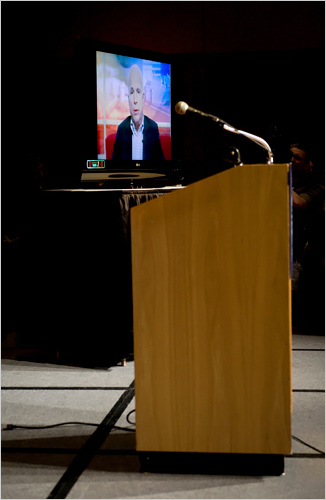Something strange is going on at the Republican National Convention. It started a few weeks ago as the list of official no shows started to unfold and grow longer by the day. The list grew longer still as hurricane Gustav acquired force in the Gulf. As the winds roared toward New Orleans, the GOP went into full theatrical mobilization to show the world that, this time, they had leaders who were READY to LEAD. Of course, those same leaders had nothing to do and a lot of air time to fill. The result was to gear up for a virtual convention. A map of the Gulf Coast became a giant screen saver in the convention hall, and Bush and McCain appeared around the edges like pop-up videos.

Here workers in St. Paul are joined by President Bush from the FEMA center in Washington. His briefing on the hurricane preparations included the news that he would not be attending the convention. Too much to do, you know. Then a funny thing happened on the way to the coast. Hurricane Gustav missed New Orleans. Crisis over. Everything under control. Local authorities just need some time to tidy up the place before letting everyone back in.
And so Bush would come to the convention after all, right? Wrong. As I’m writing this, he just gave his speech on the big screen, from the White House, in Washington. Huh? Maybe FEMA is still such a mess that the president has to help them calm down from the near miss, or maybe there is something to earlier rumors about the strategic value in having a little distance between Bush and McCain. I have no doubt that this question will be the subject of deep thought in media commentary this week. I’d like to take a different tack, however.
One of the characteristics of the digital age is that we are surrounded with screens. The multiple arrays and chance encounters with screens of all sizes create a distinctive aesthetic, one still in the making. Some of the time photojournalism is picking up on the digital environment and channeling that aesthetic. For example, there are many photographs from the primary campaign of candidates caught on screens of camcorders, cameras, cellphones, showroom TVs, airplane videos, you name it. What may be merely artistic innovation becomes particularly interesting when it captures something deeper: some current of change or unrecognized need or latent possibility. Or perhaps a hidden betrayal.
The truth captured by these vignettes of politics in a digital age is that the leadership of the Republican Party is there but not there, reporting for duty but actually somewhere else, ready to speak to their fellow citizens but only at a distance. They are virtual leaders, projecting concern while hiding behind whatever photo-op, publicity stunt, surprise announcement, or shopworn excuse they can use to avoid facing the people. Where a leader might have stood, ready to engage the American people on those issues that will test and define the nation, we see instead only an image. Indeed, today I heard a convention speaker extolling John McCain’s face. Really. The face that you see on your TV, for example. Right there, on the screen. The virtual leader.
Photographs by Brendan Smialowski/New York Times.

[…] be prophetic. The basic idea of the CivicFest replica is that ordinary citizens can put themselves virtually into the center of the U.S. government. That, of course, is not too far from the idea of democratic […]